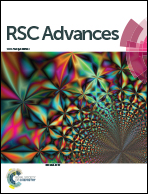Self-assembled thermosensitive nanoparticles based on oligoethylene glycol dendron conjugated doxorubicin: preparation, and efficient delivery of free doxorubicin
Abstract
An amphiphilic dendron–drug conjugate was synthesized via oligoethylene glycol (OEG) dendrons coupled with anticancer drug doxorubicin (DOX). The amphiphilic conjugate OEG–DOX (GD) self-assembled into spherical nanoparticles in aqueous solution, with mean diameters of approximately 212.5 nm. As an effective drug carrier, DOX was entrapped into GD to form drug-loaded nanoparticles (GD/D) with high drug loading content (24%, wt%), due to the enhanced hydrophobic/aromatic interactions between the DOX moiety in GD and free DOX. Besides, GD nanoparticles exhibited thermo-induced collapse and aggregation, therefore, the temperature-dependent drug release profiles of DOX from GD/D nanoparticles were measured and the possible mechanism was proposed. Moreover, hemolytic activity of GD/D revealed the good blood compatibility, and the cytotoxicity of DOX in GD/D was enhanced significantly in vitro against HepG2 cells. Overall, amphiphilic conjugate GD was considered to be potentially feasible to overcome formulation challenges for drug delivery and to be used in clinic.


 Please wait while we load your content...
Please wait while we load your content...